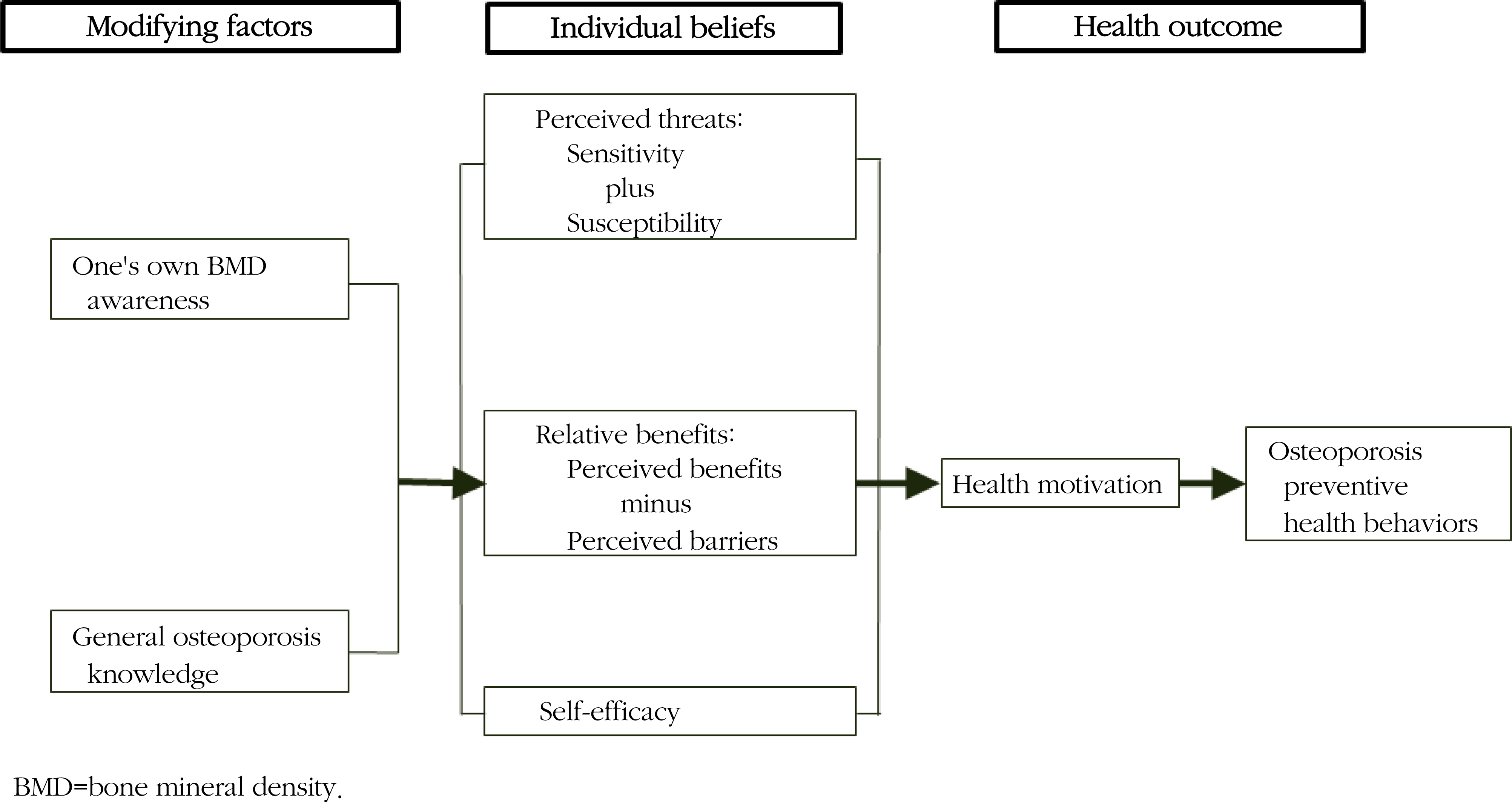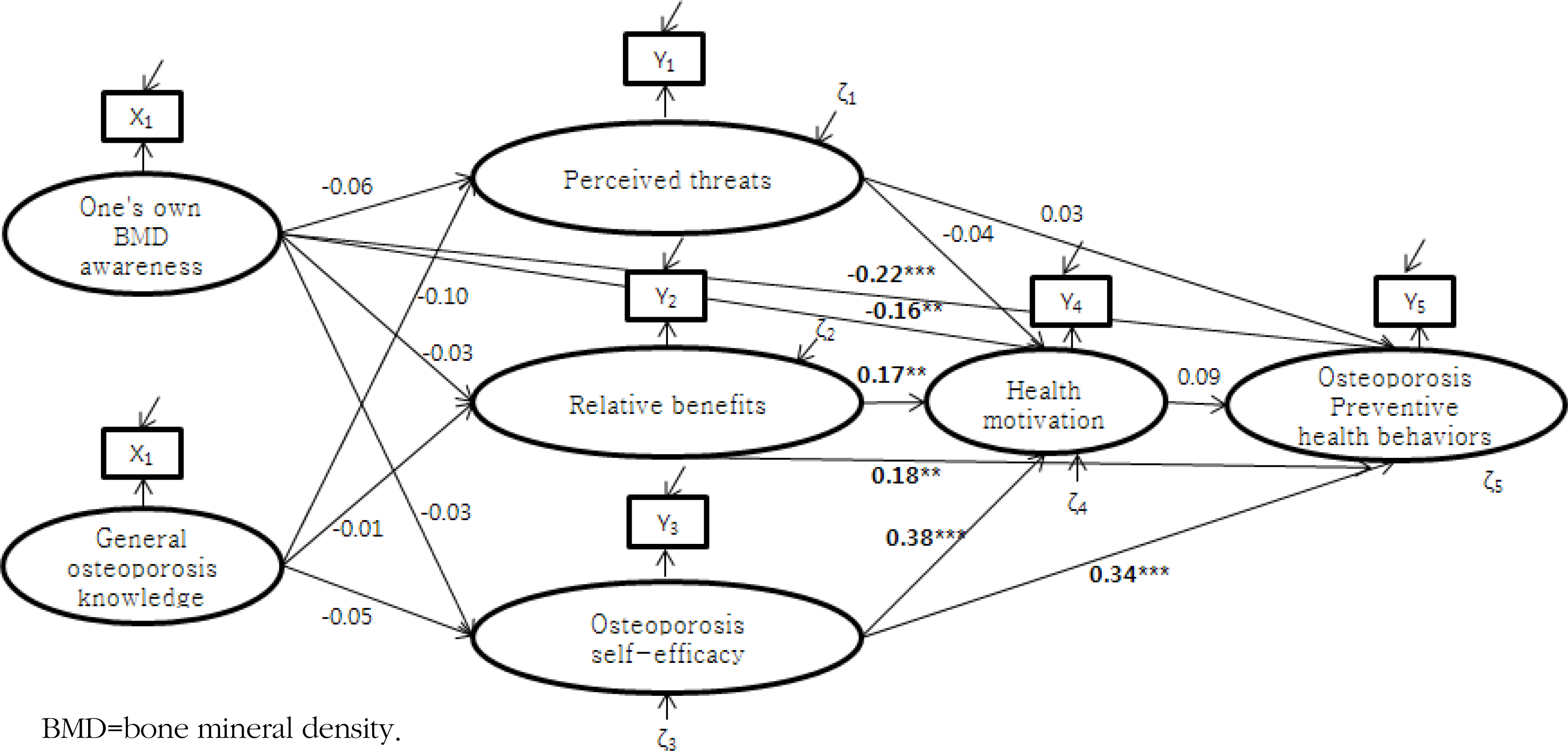Korean J Adult Nurs.
2013 Oct;25(5):527-538.
Structural Model for Osteoporosis Preventive Behaviors in Postmenopausal Women: Focused on their Own BMD Awareness
- Affiliations
-
- 1College of Nursing, Korea University, Seoul, Korea. nshin@korea.ac.kr
- 2Department of Informational Statistics, Hoseo University, Cheonan, Korea.
- 3College of Medicine, Korea University, Seoul, Korea.
- 4Graduate School, College of Nursing, Korea University, Seoul, Korea.
Abstract
- PURPOSE
The purpose of this study was to develop a model that explains causal relationships between post-menopausal women's osteoporosis general knowledge and awareness of their own bone mass density(BMD) and their osteoporosis health beliefs and preventive behaviors.
METHODS
Retrospective design using structural equation model tested seven variables by using questionnaires of osteoporosis knowledge test, osteoporosis health belief scale, osteoporosis self-efficacy scale, and osteoporosis preventive behaviors scale. 162 middle age and post-menopausal women were recruited.
RESULTS
Mediating effect of health beliefs was not significant in the relationship between BMD awareness and preventive behaviors. Instead, BMD awareness had a direct influence on the preventive behaviors that is strong and significant. Between the relationship of the BMD awareness and health beliefs, direct pathways of perceived threat, relative benefits, and self-efficacy were not significant. However, relative benefits and self-efficacy showed direct influence on the preventive behaviors.
CONCLUSION
Having middle age women get their BMD test done in order for them to be aware of their own BMD results might be a critical strategy to promote osteoporosis preventive behaviors. There is a need to develop diverse strategies to enhance their self-efficacy which has been shown to be important to osteoporosis preventive behaviors.
MeSH Terms
Figure
Reference
-
Babatunde O. T.., Himburg S. P.., Newman F. L.., Campa A.., Dixson J.2011. Theory-driven intervention improves calcium intake, osteoporosis knowledge, and self-efficacy in community-dwelling older black adults. Journal of Nutrition Education and Behavior. 43(6):434–440. http://dx.doi.org/10.1016/j.jneb.2010.07.004.
ArticleBentler P. M.., Chou C.1987. Practical issues in structural modeling. Sociological Methods & Research. 16:78–117.
ArticleByun Y. S.., Kim O. S.2000. Development of the education program and it effect on osteoporosis and life style among women. Journal of Korean Academy of Nursing. 30:764–775.
ArticleChampion V. L.., Skinner C. S.2008. The health belief model, health behavior and health education. Glanz K., Rimer B. K., Viswanath K., editorsHealth behavior and health education. p. 44–65. San Francisco, CA: John Wiley & Sons, Inc.Chang S. M.., Park C. M.., Chang S. H.., Shin C. S.., Ha Y. C.2010. Study on medical service use and prescription pattern of osteoporosis 2008-2009. Seoul: Health Insurance Review & Assessment Service.Choi H. J.2009. Risk factors and assessment of low bone mass in the young adult female. Korean Journal of Family Medicine. 3:924–933. http://dx.doi.org/10.4082/kjfm.2009.30.12.924.
ArticleDavis G. C.., White T. L.., Yang A.2005. A bone health intervention for older adultsliving in residential settings. Research in Nursing and Health. 29:566–575. http://dx.doi.org/10.1002/nur.20162.Estok P. J.., Sedlak C. A.., Doheny M. O.., Hall R.2007. Structural model for osteoporosis preventing behavior in postmenopausal women. Nursing Research. 56(3):148–158.
ArticleGammage K. L.., Klentrou P.2011. Predicting osteoporosis prevention behaviors: health beliefs and knowledge. American Journal of Health Behavior. 35(3):371–382.
ArticleHoran M. L.., Kim K. K.., Gendler P.., Froman R. D.., Patel M. D.1998. Development and evaluation of the osteoporosis self-efficacy scale. Research in Nursing & Health. 21:395–403.
ArticleHsieh C. H.., Wang C. Y.., McCubbin M.., Zhang S.., Inouye J.2008. Factors influencing osteoporosis preventive behaviors: Testing a path model. Journal of Advanced Nursing. 62(3):336–345.Johnson C. S.., McLeod W.., Kennedy L.., McLeod K.2008. Osteoporosis health beliefs among younger and older men and women. Health Education & Behavior. 35(5):721–733. http://dx.doi.org/10.1177/1090198107301331.Kim K. K.., Horan M.., Gendler P.., Patel M.1998. Osteoporosis health belief, self-efficacy, and knowledge test. Redman B. K., editorMeasurement tools in patient education. p. 307–317. New York: Springer.Laslett L. L.., Lynch J.., Sullivan T. R.., McNeil J. D.2011. Osteoporosis education improves osteoporosis knowledge and dietary calcium: Comparison of a 4 week and a one session education course. International Journal of Rheumatic Diseases. 14:239–247.Rosenstock I. M.., Stretcher V. J.., Becker M. H.1988. Social learning theory and the health belief model. Health Education Quarterly. 15(2):175–183.
ArticleSedlak C. A.., Doheny M. O.., Estok P. J.., Zeller R. A.., Winchell J.2007. DXA, health beliefs, and osteoporosis prevention behaviors. Journal of Aging and Health. 19(5):742–755. http://dx.doi.org/10.1177/0898264307304303.
ArticleSedlock C. A.., Doheny M. O.., Jones S. L.2000. Osteoporosis education programs: Changing knowledge and behaviors. Public Health Nursing. 17(5):398–402.Shin C. S.., Choi H. J.., Kim M. J.., Yu S. H.., Koo B. K.., Cho H. Y., et al. 2010. Prevalence and risk factors of osteoporosis in Korea: A community-based cohort study with lumbar spine and hip bone mineral density. Bone. 47:378–387. http://dx.doi.org/10.1016/j.bone.2010.03.017.
ArticleSun K. S.2003. The effect of web-based osteoporosis prevention program on the osteoporosis knowledge, self-efficacy, health belief, stage of change in female college student. Unpublished doctoral dissertation, Chonnam National University, Gwangju.Swaim R. A.., Barner J. C.., Brown C. M.2008. The relationship of calcium intake and exercise to osteoporosis health beliefs in postmenopausal women. Research in Social and Administrative Pharmacy. 4:153–163. http://dx.doi.org/10.1016/j.sapharm.2007.03.004.
ArticleThe North American Menopause Society. 2010. Management of osteoporosis in post menopausal women: 2010 position statement of The North American Menopause Society. Menopause. 17(1):25–54. http://dx.doi.org/10.1097/gme.0b013e3181c617e6.Waller J.., Eriksson O.., Foldevi M.., Kronhed A.., Larsson L.., Lofman O., et al. 2002. Knowledge of osteoporosis in a Swedish municipality-A prospective study. Preventive Medicine. 34:485–491. http://dx.doi.org/10.1006/pmed.2002.1007.
ArticleWaltz C. F.., Bausel R. B.1981. Nursing research: Design, statistics and computer analysis. Philadelphia: F. A;Davis Company.Won I. S.2009. A study on osteoporosis knowledge, self-efficacy, health promoting behaviors and BMD among adult women. Unpublished master's thesis, Eulji University, Daejeon.Yoon E. J.2001. The model explaining variance in health promoting behavior and quality of life in women with osteoporosis. Unpublished doctoral dissertation, Kyung Hee University, Seoul.
- Full Text Links
- Actions
-
Cited
- CITED
-
- Close
- Share
- Similar articles
-
- An Equation Model Development and Test based on Health Belief Model Regarding Osteoporosis Prevention Behaviors among Postmenopausal Women
- Prevalence of Osteoporosis of Korean Women based on Bone Mineral Density of the radius and effect of menopause on osteoporosis
- The Effect of Tibolone on Bone Mineral Density in Postmenopausal Women with Osteopenia or Osteoporosis
- Comparison of bone mineral density and vertebral fracture assessment in postmenopausal women with and without distal radius fractures
- Quantitative Ultrasound for Osteoporosis Screening in Postmenopausal Women



